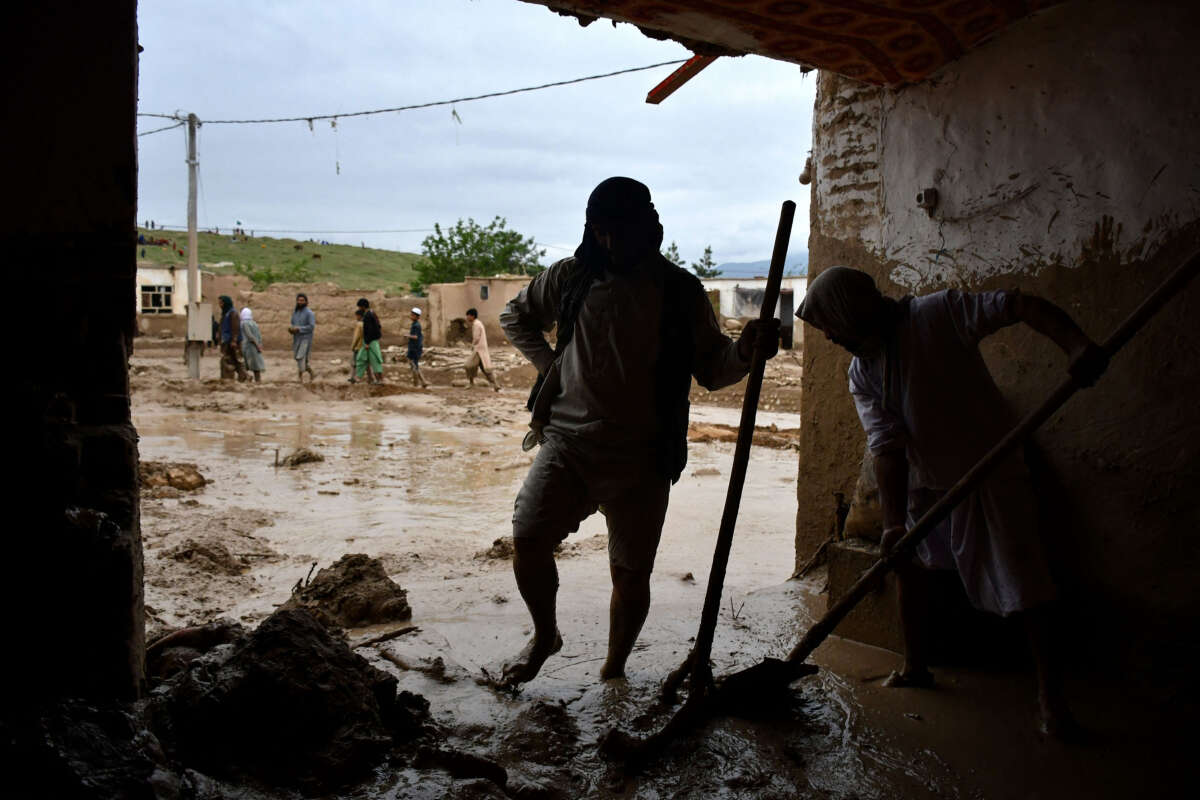Severe flooding in Afghanistan over the weekend has killed more than 300 people and destroyed thousands of homes in rural villages.
The flash floods — prompted by heavy rainfall — came on the heels of an extreme drought in one of the nations that is most vulnerable to the climate emergency, yet has done little to contribute to it.
“They’re not net emitters of carbon,” Timothy Anderson, head of the United Nations World Food Program (WFP) in Afghanistan, told CNN. “This is a subsistence agriculture community and society. So, they’re bearing the brunt of it, without having necessarily contributed to the issue very much.”
The rain and flooding inundated 21 districts in the northeastern provinces of Badakhshan, Baghlan, Takhar on Friday and Saturday, according to the U.N. Office for the Coordination of Humanitarian Affairs (OCHA). The extent of the flooding caught many villagers by surprise.
VLOG: "The 1 to 2 hours of flooding and this unfortunate situation were not anticipated by the villagers, and leaving no room for the families to move to a safer place." Ummay Habiba from @scafghanistan on the impact of the floods in northern #Afghanistan. Spox available pic.twitter.com/ysOi4KOwgk
— Save the Children Global Media (@Save_GlobalNews) May 13, 2024
In Folo in Bulka district of Baghlan province, the rain began during Friday prayers, softly at first, and then quickly building in intensity.
Resident Barakatullah told CNN that it does not often rain so high up in the mountains and that villagers had to scramble as the situation “turned dire.”
“People fled to higher ground, seeking refuge in mountains and hills,” he said. “Unfortunately, some individuals who were unable to leave their homes fell victim to the floodwaters.”
The WFP told The Associated Press that more than 300 were killed, and the U.N. Children’s Fund reported that at least 51 of them were children. The government said Sunday that the storms killed 315 and injured more than 1,600.
The survivors were left to bury the dead and tally their losses. All told, the disaster destroyed or damaged 8,975 homes, according to OCHA. In Baghlan province alone, the floods washed away at least six public schools, 10,200 acres of orchards, and 2,260 livestock and damaged 50 bridges and 30 hydroelectric dams.
“Lives and livelihoods have been washed away,” Arshad Malik, the Afghanistan director for Save the Children, told Reuters. “The flash floods tore through villages, sweeping away homes, and killing livestock.”
Farmer Abdul Ghani told the AP that he was visiting family in another province when he learned of the floods. Rushing home to the Nahrin district in Baghlan province, he found the road he usually took to his village erased, his wife and three of his children dead, and another child missing.
“My life has turned into a disaster,” he said.
Muhammad Yahqoob, who lives in the same district and lost 13 family members, told Reuters, “We have no food, no drinking water, no shelter, no blankets, nothing at all, floods have destroyed everything.”
He added that out of 42 houses that used to stand in his village, only two or three were left.
“It has destroyed the entire valley,” Yahqoob said.
Anderson of the WFP told CNN that losing livestock for many villagers meant losing all or part of their livelihoods. Further, the flooding disrupted the lives of people who were already struggling due to drought and destroyed measures they had taken to adapt, such as dams for rainwater and irrigation canals.
“It was already pretty grim. And now it’s catastrophic,” he told CNN.
The current disaster also follows rains and flooding in April that killed 70 and destroyed around 2,000 homes in southern and western provinces, according to AP.
The U.N. lists Afghanistan as one of the countries most vulnerable to the climate crisis, and it also lost a significant amount of foreign aid when the Taliban took control in 2021. The aid has only decreased in the years since.
While decades of war means that Afghanistan faces unique challenges, it’s not the only country that has been inundated with severe rain since the start of 2024. Extreme flooding this spring has displaced nearly a quarter million people in East Africa and half a million in southern Brazil.
“The climate crisis continues to rear its ugly head,” Teresa Anderson, the global climate justice lead at ActionAid International, said in a statement. “With the latest incident, Afghanistan joins a long list of Global South countries grappling with floods this year. And this is as the world continues funding the climate crisis by expanding fossil fuels and industrial agriculture.”
“How many more tragedies must happen for the world to prioritize climate action?” Anderson asked. “It’s time to back climate action with the necessary climate funding. Communities, like those in Afghanistan, need this money to build resilience to climate impacts and pay for the losses and damages already caused by the climate crisis.”
Our most important fundraising appeal of the year
December is the most critical time of year for Truthout, because our nonprofit news is funded almost entirely by individual donations from readers like you. So before you navigate away, we ask that you take just a second to support Truthout with a tax-deductible donation.
This year is a little different. We are up against a far-reaching, wide-scale attack on press freedom coming from the Trump administration. 2025 was a year of frightening censorship, news industry corporate consolidation, and worsening financial conditions for progressive nonprofits across the board.
We can only resist Trump’s agenda by cultivating a strong base of support. The right-wing mediasphere is funded comfortably by billionaire owners and venture capitalist philanthropists. At Truthout, we have you.
We’ve set an ambitious target for our year-end campaign — a goal of $240,000 to keep up our fight against authoritarianism in 2026. Please take a meaningful action in this fight: make a one-time or monthly donation to Truthout before December 31. If you have the means, please dig deep.
